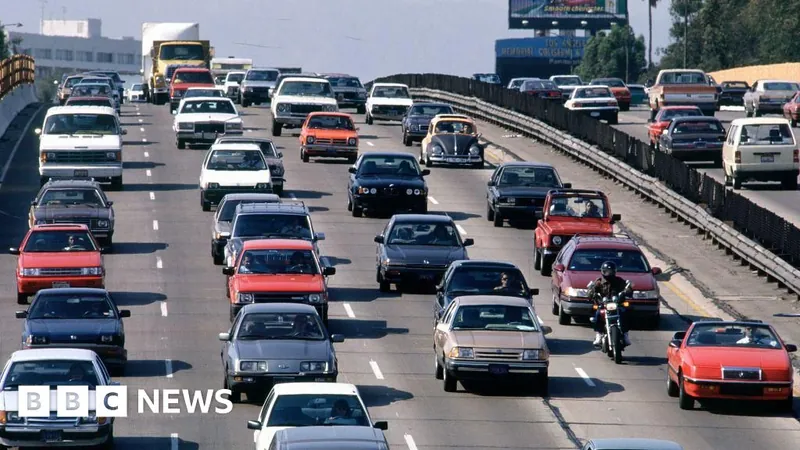
Can Bike Lanes Revolutionize Los Angeles’ Car Culture Ahead of the Olympics?
2025-01-01
Author: Sophie
Introduction
Los Angeles, long hailed as the epicenter of American car culture, is facing a potential transformation as it gears up for the 2028 Olympic Games. Known for its sprawling landscapes and traffic-choked freeways, the City of Angels has traditionally favored cars over cyclists and pedestrians. However, with an influx of events such as the upcoming 2026 World Cup and a pressing need for improved transportation, the era of bike lanes may be upon us.
The Cycling Potential of Los Angeles
With its enviable year-round weather, LA presents an ideal setting for outdoor activities, including cycling. Damian Kevitt, executive director of Streets Are For Everyone (Safe), expresses optimism about the city’s cycling potential. “It is the perfect community for runners and cyclists, yet we seem permanently attached to our vehicles,” he said, highlighting the city's ingrained dependence on driving.
Current Commuting Statistics
Historically, only about 1% of Los Angeles residents commute by bike, with public transit usage hovering around a mere 7%, according to the Neighborhood Data for Social Change. As the city prepares for the attention of the World Cup and Olympic Games, planners have turned to the “Twenty-eight by '28” initiative, which aims to expand public transit and construct extensive bike lanes. This initiative aims to address the city’s mobility challenges and potentially reshape its transportation culture.
Resistance to Change
Yet, shifting a deeply entrenched car-centric mindset is no small feat. Despite recent efforts, there is resistance among some residents. Critics argue that bike lanes exacerbate congestion. Darin Drabing, the president and CEO of Forest Lawn Cemetery, is vocal about his opposition to a proposed bike lane near the cemetery, fearing it will disrupt commutes and funeral ceremonies. “I’ve seen bike lanes create chaos. I don’t believe they address the core issues of congestion,” he asserted.
Success in Other Cities
Once controversial, protected bike lanes have demonstrated success in other Olympic cities, including Paris and London. However, recent developments show that debates around bike lane implementations can still create backlash. For example, the city of Glendale recently voted to remove certain bike lanes following complaints about the subsequent traffic increases. Likewise, modifications to Hollywood Boulevard have led to frustrations among drivers, with reduced traffic flow, but have also encouraged some residents to reconsider biking as a viable commuting option.
Personal Stories of Cyclists
Cyclists like Mimi Holt have personal stories of resilience, highlighted by her return to biking after years away from the sport due to fears of traffic. After a health scare, she decided to reclaim her fitness, stating, “I feel much younger biking around the city, and I can't wait for the bike lanes to be fully connected.”
Mayor's Vision and Challenges
Los Angeles Mayor Karen Bass has been advocating for a “transit-first” approach leading up to the Olympics, signaling a paradigm shift in how the city views transportation. Yet, the progress of the Twenty-eight by '28 projects is slower than anticipated. Currently, only five out of 28 targeted projects have been completed, and the timeline for full execution remains tight.
Funding Support
Nevertheless, financial backing could play a crucial role in expediting these projects. LA has secured $900 million from the Biden administration to support transit initiatives, and Mayor Bass is pushing for an additional $3.2 billion in federal funding, which she defined as critical for hosting a successful and inclusive Olympic experience.
Conclusion
In conclusion, Los Angeles stands at a crossroads, with the potential to redefine its relationship with cars and bikes alike as it prepares for the world’s spotlight. With an ambitious plan for bike lanes and an increasing public willingness to embrace change, the City of Angels could very well become a model for sustainable urban transportation. The question remains: will Angelenos embrace this shift, or will they cling to their cars in the face of a cycling revolution?



 Brasil (PT)
Brasil (PT)
 Canada (EN)
Canada (EN)
 Chile (ES)
Chile (ES)
 Česko (CS)
Česko (CS)
 대한민국 (KO)
대한민국 (KO)
 España (ES)
España (ES)
 France (FR)
France (FR)
 Hong Kong (EN)
Hong Kong (EN)
 Italia (IT)
Italia (IT)
 日本 (JA)
日本 (JA)
 Magyarország (HU)
Magyarország (HU)
 Norge (NO)
Norge (NO)
 Polska (PL)
Polska (PL)
 Schweiz (DE)
Schweiz (DE)
 Singapore (EN)
Singapore (EN)
 Sverige (SV)
Sverige (SV)
 Suomi (FI)
Suomi (FI)
 Türkiye (TR)
Türkiye (TR)
 الإمارات العربية المتحدة (AR)
الإمارات العربية المتحدة (AR)